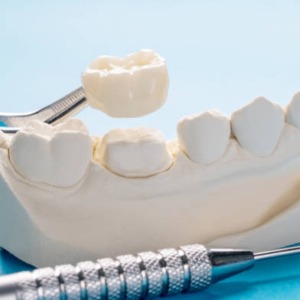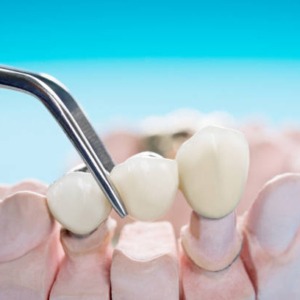What are crowns?
Crowns are tooth-shaped caps which fit over your teeth.
Why are crowns used?
Teeth with large fillings (and/or root fillings) are weak and can break when you bite. They can have hidden cracks which make them tender to bite on or sensitive to hot or cold. A crown will protect a heavily filled tooth.
Crowns can also be used cosmetically to improve the appearance of teeth.
Your dentist can tell you which of your teeth would best be protected by crowns before problems develop.
What are crowns made of?
Usually porcelain, because the colour can be matched to your existing teeth. The porcelain ‘tooth’ may have a gold or other metal core for strength. If a natural appearance is not essential (eg at the back of your mouth), a gold or other metal crown may be used.
How are crowns fitted?
Your dentist reduces the size of the existing filling and tooth to make room for the new crown, then takes a mould which is sent to a dental technician. Sometimes the filling in the tooth to be crowned is completely removed to check for decay and to rebuild the tooth for increased strength.
Your dentist will fit a temporary crown to cover your tooth until the permanent crown has been made by a dental technician. Once your permanent crown is ready, your dentist will check the fit and appearance before cementing it in place.
I have several heavily filled teeth. Should I get them all crowned at the same time?
It may be best if you do, but there are many factors to consider. Your dentist will discuss the most appropriate order of your treatment plan.
The result
Crowns provide strong, attractive, long term protection for your mouth.
I would like to whiten my teeth. Should I do this first?
Yes, because the crown is made to match the colour of your teeth. If you whiten your teeth later, the crown will not change colour and will appear darker compared to the rest of you teeth.
Bridges
A bridge is an artificial tooth supported by the teeth on either side of the space.
Your dentist prepares your teeth on either side of the gap, and takes a mould which is sent to a dental technician. The dental technician makes the complete structure, using porcelain (for appearance) and a metal core (for strength). Your dentist then places the bridge into your mouth. Bonded bridges that do not require shaping of the neighbouring teeth are sometimes used.
Stronger materials are sometimes necessary for bridges used in back teeth. Your dentist may use an all-metal, gold bridge for this.
A bridge is a long term, very attractive way of helping you fill the gap.
Content Acknowledgement: NZDA: For more info: The New Zealand Dental Association (NZDA)




